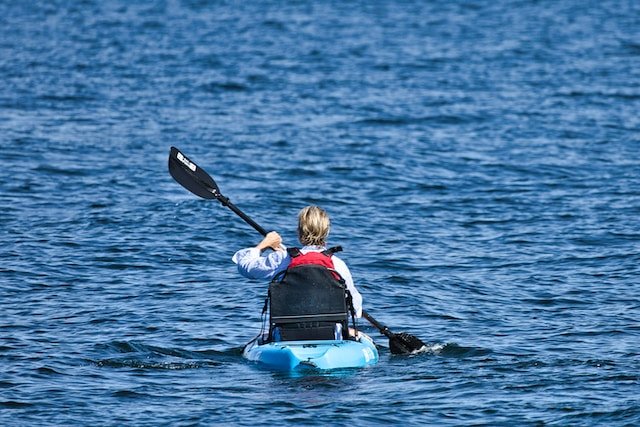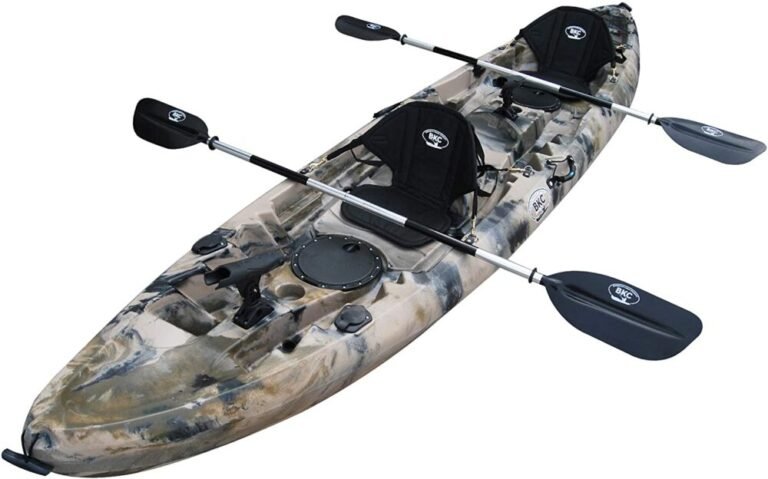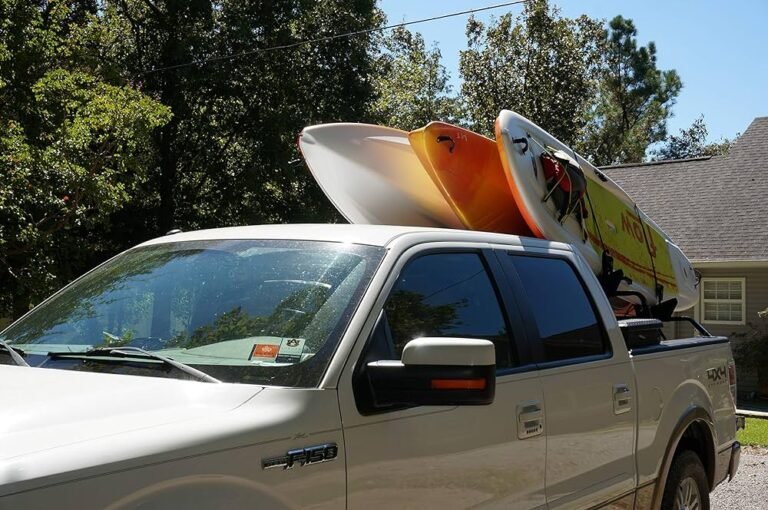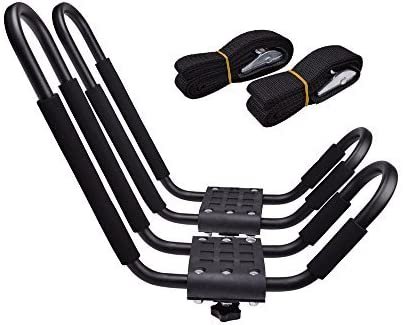10 Best Kayak Anchors To Buy In 2024
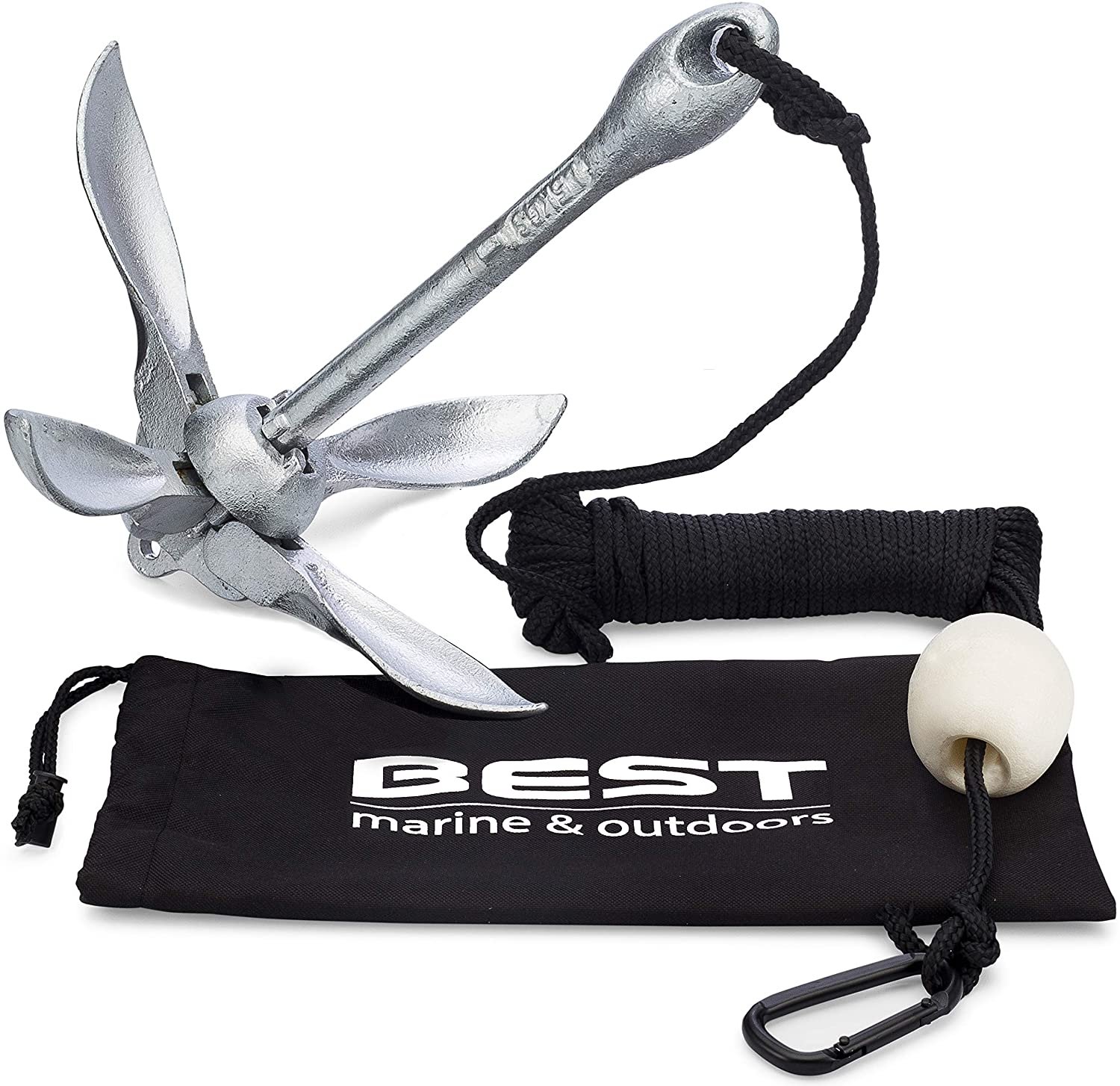
Kayaking is all about moving forward and paddling along a beautiful coastline. However, there are moments when you have to enjoy the scenic landscape, snap photos, take a break from paddling or kayak fishing, catch up with some chums or stay in a specific place for fishing.
To prevent your kayak from drifting away even if the wind picks up or the current grabs you, anchors are essential part of the kayaking gear you need.
Anchoring is a great way to put the pedals and paddle down and focus on fishing. The compact nature of an ideal kayak anchor makes transportation easy, especially for anglers.
Read through this review with a list of dependable anchors for your kayak and the appropriate way to secure your vessel.
1. Extreme Max Complete Grapnel Kayak Anchor
Extreme Max is an outdoor gear that is built with convenience in mind. The BoatTector 3.5 lb. Grapnel Anchor Kit features a folding four-fluke anchor that offers a solid grip in most conditions, a durable marine-grade market in-line buoy, and a 25-foot hollow braid polyethylene anchor rope with a plated steel snap hook.
The included sturdy nylon storage bag is padded to prevent damage to the kayak or the anchor during storage and the bright red color makes it visible.
The Complete Grapnel Kayak Anchor kit is a great utility accessory for kayaks, paddle boards, canoes, and small inflatable boats that can be used in coral, rocky, or heavily weeded bottom conditions. Despite being affordable, it functions greatly and securely holds a few kayaks at the same time.
Pros
- Reliable fluke system
- Holds on different surfaces including heavily weeded, rocky, or coral surfaces
- It includes a sturdy, padded storage bag
- It is affordable
- Can securely hold a small group of kayaks
- Has a collar to lock the flukes
- Brightly colored and easily visible
- Very affordable
Cons
- Short hollow braid polythene anchor line
- Small Marine Foam Marker Buoy
- Carabiner might need to switch
2. Airhead Complete Grapnel Anchor System
The complete grapnel anchor from Airhead is a reliable red anchor that works best in shallower waters.
Featuring a 3-1/3 pound galvanized and powder-coated 4-fluke folding anchor that ensures corrosion resistance, a durable nylon storage bag that is padded to protect the kayak and the anchor from potential damage and likewise dampen noise while the anchor is stowed.
A 25 ft. long marine-grade rope, with an in-line buoy and a stainless steel snap hook is included to this anchor kit as well. This complete grapnel anchor from Airhead is designed to temporarily secure your small boats, sailboats, personal watercraft, inflatable boats, canoes, and float tubes.
Pros
- Galvanized, powder-coated, rust-resistant 3.3-pound anchor
- Hold well in sand, gravel, mud, or rock
- Everything’s brightly colored for visibility
- An in-line buoy helps retrieve the anchor
- A padded nylon bag and marine-grade nylon rope included
Cons
- Meeting the scope recommendations with a 25-foot line is difficult
- Constant use of rope especially when not handled with care may cause the rope to fray
3. Gradient Fitness Marine Anchor
The Gradient Fitness Marine Anchor is a folding 3.5-pound grapnel anchor that is best suited for kayakers who paddle in rougher waters.
It comes with a four-fluke folding design that ensures kayak-friendly compactness, a padded drawstring bag for storage, 25 feet of marine-grade rope, a PVC floatation buoy, and a stainless-steel snap hook.
The included bright green anchor is rust-resistant although it’s not recommended for saltwater use and the slightly heftier design works well in strong currents and choppy waters.
Despite being small and lightweight, it can be used on various bottoms with sand, rocks, mud, and weed.
Pros
- Rust-proof and the powdered green coating improves visibility
- Grips across various surfaces
- Suitable for rough waters
- A sturdy, padded drawstring storage bag included
- Can be easily and quickly attached
Cons
- There is a need to replace the rope since it is short
- Can only work well with the use of a 5-feet mid-heavy chain
4. Best Marine Kayak Anchor
The Best Marine anchor is designed specifically for user convenience.
This folding kayak anchor is compact enough to carry on any kayak, paddleboard, canoe, jet ski, and small boat, but when the flukes are open, it’ll dig into the river/lake bed and remain stationary in moderate flow or current even when there are massive weeds, branches, and roots.
To use the anchor, you can simply slide the built-in collar upward and layout the flukes. The anchor is rust-resistant and highly durable since it is made using galvanized iron.
It features a 40-foot length of rope and a buoy, as well as a stainless-steel carabiner for an easy clip to your kayak even without a mount. It weighs 3.5 pounds and comes with a warranty if you’re not fully satisfied.
Pros
- 40-foot, highly durable rope included
- Good weight for all kayak sizes
- Quick-release/secure anchor collar
- Highly versatile
- Compatible with a trolley
- Made of rust-resistant, galvanized
- Works on different bottoms with weeds, branches, roots, and rocks
Cons
- The small buoy can easily get lost
- The rope isn’t marine-rated
- The bag may not be thick enough to prevent the flukes from damaging an inflatable kayak hull
5. Seachoice Folding Grapnel Anchor
Are you in search of quality and affordable kayak anchors? Give this grapnel anchor a try! Compared with their counterparts, it costs as much as 50% less.
It doesn’t include an anchor line, but it is durable enough to last you a long time. It features a heavily galvanized malleable iron, making it rust and corrosion-resistant, even in saltwater. All thanks to the built-in collar.
The anchor is easy to lock into both open and closed positions and it can be folded up to reduce its size for easy storage when not in use. The Folding Grapnel Anchor weighs 7 pounds and is ideal for use by small watercraft and dinghies.
Pros
- Dependable and sturdy
- Easy to fold and open
- Best-priced anchor on our list
- Perfect for kayaks, SUPs, and small boats
Cons
- No anchor line included
- Doesn’t include an eye bolt for secure line attachment
6. Attwood 11959-1 Marine Anchor
The Attwood Marine anchor is a great accessory for anchoring your kayak. They’re lightweight, yet very effective in a very wide range of anchoring conditions.
With the sturdy 1/4-inch rope that is 20 feet long, your kayak is supported and secured. For additional support, there might be a need to get a long nylon rope.
The included storage bag keeps your items safe and since it is a folding anchor, it can be neatly kept for convenient storage.
However, for an effective result, the knots of this anchor need modification and therefore require you to tie it again or replace it with a good anchor knot.
Once this is done, not only will it securely hold in place Your kayak, canoes, rafts, dinghies, or flat tubes, but it does also hold up two jet skis at the same time.
Pros
- Securely holds your kayak on the muddy bottom and swift current
- Works in different conditions
- Great for fishing kayaks or kayak anglers
- Capable of holding up to three small boats at the same time
- Has a reliable strength
- Can be folded for convenient
Cons
- The knot needs to be modified
- The rope is short for some users
7. YakGear 5lb Mushroom Anchor
YakGear’s inverted mushroom type, among others, is one of the most popular small anchors for anchoring kayaks, canoes, stand-up paddleboards, and even joining boats in muddy, sandy, or weeded bottoms.
This 5-lb inverted mushroom anchor is constructed from cast iron and coated with black vinyl to ensure long-lasting dependable use. Its high-level holding strength offers additional security
Shaped like an inverted mushroom, the head becomes buried in the soft seabed and will normally sink into the point where it holds on to muddy and weedy bottoms without being caught up with plants and roots. This is one of the best options for fishermen and it can be used as a buoy.
Pros
- Best for fishing and shallow water
- Easy to handle
- Anchor well on the weedy and muddy
- Can anchor buoys and water toys
- Has a smooth look with a vinyl coating and cast iron body
Cons
- There’s a need for a marker buoy to avoid losing the anchor
8. OLIVIA & AIDEN Folding Kayak Anchor
The Olivia and Aiden anchor is a compact and folding anchor that is best for small fishing boats, kayaks, canoes, or paddle boards. For every one of your outdoor adventures, this is a perfect choice to take along with you.
Made with galvanized steel, it is rust-resistant and the smart, well-balanced fluke structure paves the way to a much better hold and more horizontal drag.
This kayak anchor weight is 3.5 pounds and heavy enough for mooring. It is compact with easy-to-store size, works well for fishing or personal watercraft and grapples well on pond, lake, river, or ocean bottoms.
To support the excellent function of this solid anchor, each anchor includes a 40ft grapnel anchor line with an attached buoy to help you easily identify and pull up your anchor in any water. It also features a locking collar for extra security of the hold.
With this affordable anchor, mooring your kayak is made easier and secured. However, one of the negative sides of the anchor is that the seams might get ripped after using the bag a few times.
Pros
- Sturdy and solid fluke design
- Durable storage bag
- Good for mooring
- More affordable and offers a satisfaction guarantee
- Its design makes for a much better hold and more horizontal drag
- Has a 40-feet anchor line
- Works on any bottom
- Compact and folding for easy storage
Cons
- Small buoy
- Anchor line quality
- After several uses, the seams of the storage bag got ripped
9. Cooper Anchor 1Kg/2.2lb Nylon Plow Anchor
Are you sick and tired of fussing with foldable grapnel-style anchors and need a lightweight and compact anchor?
This is the anchor for you! There’s no need for folding or unfolding flukes, filling sandbags, or carrying excess weight on your kayak. The Bruce Anchor design makes it easy to secure your boat in place with minimal fuss.
It is lightweight at 2.2 and best suited to milder conditions and slow currents.
Made from nylon, it is rust-resistant although it is prone to damage from rocks and gravel. Quite expensive but a perfect solution to keep yourself securely anchored.
Pros
- Easily deployed and stowed
- Lighter-weight
- Securely hold your kayak to rocky or gravelly riverbed
- Easy to set without the need to recheck your hold
Cons
- No anchor line included
- Pricey
- Nylon is more susceptible to cracks and scratches than steel
10. CALPALMY 2-in-1 Sand Anchor
The uniqueness of this anchor among others is the fact that you can have this anchor fill up with 50 Lbs of Sand and that’ll be enough to keep your craft steady in the water. Constructed with heavy-duty PVC material, it can anchor your jet ski and paddle board.
When empty and the roll-top is folded, this watertight compression sack will keep your clothes, towels, food, flashlight, and phone nice and dry. It also acts as a buoy. Included in this multi-purpose bag is a handy bottom strap for easy dumping, a 12-foot braided rope, and two rustproof stainless-steel clips.
All thanks to the bright yellow with red ropes, which makes it highly visible even in murky water. Securely anchor your kayak in the ocean waves, river rapids, or a choppy lake with this incredible sack.
Pros
- The weight and heaviness depend on how much you fill it
- Easy to empty and refill
- Made from durable heavy-duty PVC
- Doubles as a watertight dry bag
Cons
- The anchor line is very short
- It May be damaged if dragged over sharp rocks or gravel
Factors To Consider Before Purchasing A Kayak Anchor
The great thing about kayak anchors is that they are simple tools with a bit of weight and maybe a hook or extending arms to drag on the bottom of the river or lake bed to secure you in place.
However, there are a few factors that you’ll need to consider before purchasing the right anchor for your kayak.
Material
Kayak anchors are constructed using different materials. While most are made from galvanized, stainless steel, or even aluminum, stakeout poles are often made of fiberglass with a pointed tip to drive into the soft bottom.
Galvanized or stainless-steel anchors consist of a waterproof coating which makes them rust-proof and if you’re fishing in saltwater, it protects against salt build-up. On the other hand, aluminum material is known for being lightweight.
Anchor Line
The rope, chain, or paracord used to secure the anchor to your boat is what is referred to as an anchor line. The rope and paracord are light and compact.
Made from synthetic, marine-grade materials, they are very resistant to deterioration. But the chain is not only tough but heavy as well.
Weight
The weight of the anchor is another important factor to consider. Overloading your kayak increases the risk of capsizing and at the same time, there’s a need for an anchor that is heavy enough to keep you from drifting while you’re fishing.
This simply means that a bit of weight is required for the anchor to stay firmly in place while dragging along the bottom.
However, compared with the mushroom and drag chain anchors which tend to be heavier in the 3 to 3.5-pound range, there are alternative options like grapnel, plow, and Bruce anchors which are lightweight and in the 1.5 to the 3.5-pound range.
Keep in mind that on calm days, a 1.5-pound anchor dug into the ground is enough to keep you from drifting but with faster currents or high winds, an anchor that weighs 3 or 3.5 pounds ensures you’re securely anchored in place.
The scope
The scope of the anchor refers to the length of the chain or rope relative to the depth. Having enough rope ensures that your kayak doesn’t tip over on the side or snag at the bottom. On the other hand, when the rope is too long, it can get tangled or caught up in debris.
Stabilizing the kayak will be difficult if the rope is not sufficient and to always make sure you’ve got enough rope in any situation, have a rope length that is seven times longer than the depth of the water.
Anchoring Points
Anchoring points are as important as determining the appropriate anchor type and the line. Usually, the anchoring point of a kayak is the bow or stern.
Watercraft are not only long and narrow, they’re equally designed to cut across waves. This implies that if anchoring is done at the midpoint, the kayak may turn sideways and waves may break on the sides of the kayak and cause swamping.
Unlike the inflatable and folding types, some anchors don’t come with mounting points. To fasten the anchor rope, common tools like rope knots and screw-clips, and carabiners are used.
Accessories
Included in your Kayak Anchor are some handy accessories. You would usually get 25 to 35 feet of rope although there might be a need for an additional rope.
A snap hook for easy attachment on a kayak’s bow or stern goes along with the rope. This hook is durable if it’s made of stainless steel or galvanized steel. To see the rope with ease even when you’re out of the water, a marker buoy is included.
A nylon storage bag and padded storage bag keep the line out of the way when the anchor isn’t in use. But for your outdoor adventure, a dry bag secures kayaking gear very well.
Kayak Anchor Trolley System
An anchor trolley is used on the kayak, especially when sailing on a large body of water to freely change the mounting point either on the bow, stern, or fly to secure a tipping kayak in swift water and wind.
After dropping the anchor in the water, have this thin rope’s (550 paracords) end tied to a small carabiner, and then pull the trolley line to move the anchor rope with the carabiner to the stern or bow of the boat.
With an additional trolley kit, water is prevented from sloping on the side when the kayak turns because of the waves. Most people use an anchor cleat instead of an anchor trolley system.
Types of Kayak Anchors
There are a variety of kayak anchors available in the market and getting to know them will help you make a wise decision upon purchase. The following are the various types of kayak anchors.
Grapnel Anchors
Grapnel anchors, also referred to as folding anchors, have four folding arms (called flukes or extensions) that dig into the river/lake bed and secure your kayak in place.
Considered the most effective anchor and for their convenient size, they’re common among kayakers. They’re affordable, easy to deploy, and are often heavy enough to serve as a drag anchor without needing to deploy the arms.
The stability of a grapnel anchor can be seen in how it grasps any type of soil although sometimes, they’re prone to get stuck in place.
Mushroom anchors
These inverted mushroom-shaped anchors are heavy with a minimum of 10 lbs and rely entirely on their weight to keep you from drifting.
When they’re dropped into the water, they settle onto the bottom of the river or lake and hold you in place. They are mostly used by motorized boats and are less popular among kayakers due to their weight.
Bruce Anchors
This type of kayak anchor looks like oversized fishing hooks and works similar to plow anchors. It works best on sandy bottoms.
To securely hold you up in a place, once it hits the river/lake bed, it drags along behind you until the hook either buries itself deep enough in the soil or snags on some obstacle to stop the kayak from moving.
Plow Anchors
Plow anchors are designed and function like the farmer’s plow. With the long, straight shaft attached to a blade, they pierce through the floor of the pond and lake anchoring you in place.
This type of kayak anchor can be hard to set, but once in place, it assures you of a stable position on the water.
Stakeout Poles
Stakeout poles are mostly used by anglers who always dock their kayaks in shallow waters. For an effective result, bury them in the lake or river bed, or on the banks of the river.
While some are weighted enough to bury themselves once they’re dropped into the water, others need you pressing them tightly into the soil.
Drift Chutes
A drift chute or a drift anchor can be best described as a water parachute. Used mostly by the small motorized watercraft but they can work to keep your kayak from drifting too far off course.
When deployed, it works to complement the main anchor by scaling down the motion of the kayak or small watercraft.
Drift socks won’t fully STOP you (the more reason why they’re used to compliment another anchor type) but they maintain correct heading and keep your kayak pointed in the right direction for the best fishing.
Sand Bag
As the name implies, this is a bag filled with sand (depending on how much weight you’re carrying/using for anchor) that sits at the bottom of the river/lake bed to hold your kayak in place.
Drag Chain
This type as the name implies is a heavy chain that drags along the bottom of the river or lake, using both the chain’s weight and the contact with the river/lake bed to slow you down. They’re best suited to shallow rivers and occupy a lot of space in your Kayak.
Why Use A Kayak Fishing Anchor
Users can gain different benefits from using a kayak anchor and having the most suitable type boosts the advantage when it comes to value, safety, and stability. Among many other kayak’s gear, an anchor is the most reliable defense from raging water currents.
No matter how much effort you put into paddling to maintain the stability of your vessel, the paddle and your arms may not be enough to protect you from the sudden acceleration of current while fishing in calm water but with the help of a kayak anchor, you’ll be ready to face even the toughest circumstances at any time.
Apart from safety, a kayak anchor allows you to do things while it keeps the vessel grounded. For instance, an anchor will have your back if you want to take a photo of the breath taking scenery. They have also proven to make fishing productive.
Kayaks without an anchor can easily drift away in directions that you don’t intend them to be. To benefit from all the features, make sure you know the depth of the water before you choose the length of the anchor and ensure you know how to properly use the chosen kayak anchor. In this way, the stability of your kayak is guaranteed.
Another benefit is that having an anchor kit is cost-effective compared to getting only one product. A kit includes a nylon rope or anchor line, a marker buoy, and sometimes, a snap hook.
Rigging an Anchor on a Kayak
Rigging an anchor on your kayak is never a difficult task if your kayak comes with special anchor mounts. This specialized hardware mounted to your kayak is where the anchor rope or line is run through to hold your kayak in place.
However, anchor mounts are not included in most kayaks which require you to get them separately. Bolted to your kayak’s hull, they protect the hull and provide a solid anchor point to secure the line.
The Yak Attack Lever Lock Deluxe Anchor Trolley is a top-rated, highly durable mount that provides you with a solid anchor point to secure the anchor line.
Most importantly, to prevent the line from running out once the anchor is securely in place, we recommend you use an anchor lock system.
The Scotty Side Deck Mount is a great option because it has easy lock-and-release action which is assumed to be safe for reeling in and letting out your anchor. Alternatively, you can make use of a simple cleat.
In addition, instead of carrying up yards and yards of cold, wet anchor rope every time, a reel or winch will do the heavy lifting for you and keep your hands (mostly) dry. In this case, we will recommend Scuba Max Dive Reel or the Anchor Wizard.
Care and Maintenance
To prolong the lifespan of your anchor just as with the rest of your kayak gear, you need to take proper care of your anchor to prevent it from rusting or breaking. Cleaning the anchor every time after use should be a basic practice to eliminate and prevent damages from occurring.
Before the situation escalates into needing replacement and repairs, you only need water, a mild cleaning detergent, and a sponge to carefully remove “saltwater” (one of the things that harm the anchor the most), bacteria or algae, and any corrosive particles.
Most importantly, keep your anchor away from UV rays. Once it is dry, store it up because having it stay under the sun for a long time, the anchor itself and your line will be degraded and weakened.
After use, inspect the rope/chain, anchor mounts, trolleys, reels, and locking systems, and tighten any bolts as needed. Take care of them as well and keep them in good condition.
Frequently Asked Questions
How do you anchor a kayak on a river?
Anchoring a kayak on a river requires you to know and understand what to do in different situations.
When on a sailing journey and the current looks unsafe, it’s possible to anchor your kayak but before that, you need to know the depth of the water, strength of the current, kayak’s dimension, the composition of the bottom, length of the anchor line, anchor type, attachment point of the kayak, and the possible retrieval method.
This helps you to know how safe or unsafe it is to anchor your kayak at that point. Preferably, gather information about the possible water condition before the day of your adventure to avoid facing a relatively strong current.
What size anchor for a kayak?
The most common preference is a 3-lb anchor. However, some may prefer to work with 1.5-lb which is lightweight. But the perfect length for stakeout poles or stick-like anchors is from six to eight feet.
How Do I Anchor A Kayak?
The reason for anchoring a kayak is to secure the boat in a place with the least amount of weight. Before heading into big water, there’s a need to learn how to anchor your kayak.
Step 1:
Coil the rope loosely on the kayak and quickly clip the line through the carabiner on the anchor trolley after you must have dropped the anchor into the water.
Step 2:
Fasten the anchor trolley to the bow or stern and make sure you keep releasing the line until you have twice as much line out as the depth of the water once the anchor hits the bottom.
Step 3:
Pull the anchor rope to tighten the line. If the anchor drags, there’s a need to release more lines. Secure the rope in the kayak once the boat stops.
Step 4:
Using a small, plastic cleat is the best way to tie off the anchor line but for a low-profile and quick-release connection, use a jam cleat to hold the line.
Step 5:
Also, releasing the anchor quickly and smoothly is another important thing to consider. Pulling out the anchor required you to first clear the space on the deck for the anchor rope.
Afterward, pull in rope and have them looped on the deck until the kayak is directly over the anchor. Finally, retract the anchor trolley and pull the anchor out of the sand and into the boat.

